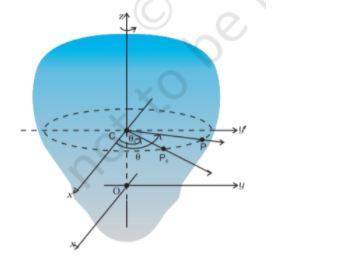Introduction
Kinematics is the branch of mechanics. It explains how the machine works, and the mechanisms involved, different kinematic links and pairs at a higher level. There are three basic concepts in kinematics- speed, velocity, and acceleration.
Kinematics
Kinematics is the study of motion, without regard to forces or torque. It is the first step in the analysis or design of a mechanism. To describe motion, kinematics studies the trajectories of points, lines and other geometric objects including their differential properties (such as velocity, displacement, time and acceleration).
Kinematics of rotational motion about a fixed axis
The motion of the rigid body is a combination of translation and rotation. If a body is fixed at a point along the line, it has only rotational motion. The rotational about a fixed axis involves only one independent variable to describe the motion.
Reference: NCERT
Angular displacement is a vector quantity measured in radians and defined as the shortest angle between the initial and final points of an object undergoing circular motion about a fixed point.
θ = s/r
Angular velocity is the time rate of change of angular displacement.
ω = dθ/dt
Angular acceleration α is defined as the time rate of change of angular velocity.
α = dω /dt
The kinematical quantities in rotational motion, angular displacement (θ), angular velocity (ω) and angular acceleration (α) respectively correspond to kinematic quantities in linear motion, displacement (x), velocity (v) and acceleration (a).
Reference: NCERT
Where θ൦ = initial angular displacement of the rotating body and ω൦ = initial angular velocity of the body.
Formulas of Kinematics
Kinematics of Machines for Class 11
Kinematics is a vast subject in physics. At this level, one must know the definitions and formulas of kinematics. The problem-based questions are more from this topic. The topic has a weightage of 5 marks.
Illustrative Examples
1. An object dropped from the top of the building. What is the velocity of an object after t= 1.5 sec?
v=v0+at
v0 = 0, (it started at rest) ; t= 1.5 sec; a = -9.81 m/s^2(freely falling object).
v=v0+at = 0 +(- 9.81)*1.5 = -14.71 m/s.
2. A car starts from rest and accelerates uniformly over a time 4.78 seconds for a distance of 110 m. Find out the acceleration of the Car?
GivenΔx = 110m; t= 4.78s; v = 0 (rest)
Δx = v0t+1/2at2
110 = 0*4.78+1/2 *a*(4.78)^2
110 =11.4242a
a=9.62 m/s^2
3. A kangaroo is capable of jumping to a height of 1.62 m. Determine the takeoff speed of the kangaroo?
v2=v02+2aΔx
v2= 0; a =-9.81 m/S^2 ; Δx = 1.62 m
0 = v0^2 +2*(-9.81)*1.62
v0^2= 31.87
v0 =5.64 m/s
FAQs on kinematics of machines
1. What is the difference between kinematics, kinetics and dynamics?
2. How is kinematics used in real life?
3. When can kinematics not be used?
4. What are scalars and vectors?
5. What are the different types of Machines?
News & Updates
Physics Motion Exam
Student Forum
Answered a month ago
Ecole Intuit Lab Bengaluru BDes (Hons) in Animation and Motion Design is a 4 year UG programme. The Institute offers this programme in full-time mode, on the basis of merit. Therefore, the eligibility criteria includes a qualification of Class 12 with a minimum of 45% aggregate. Intuit Lab Bengaluru
A
Beginner-Level 4
Popular Courses After 12th
Exams: BHU UET | KUK Entrance Exam | JMI Entrance Exam
Bachelor of Design in Animation (BDes)
Exams: UCEED | NIFT Entrance Exam | NID Entrance Exam
BA LLB (Bachelor of Arts + Bachelor of Laws)
Exams: CLAT | AILET | LSAT India
Bachelor of Journalism & Mass Communication (BJMC)
Exams: LUACMAT | SRMHCAT | GD Goenka Test



What is the fee for BDes (Hons) Animation & Motion Design at Ecole Intuit Lab Bengaluru?